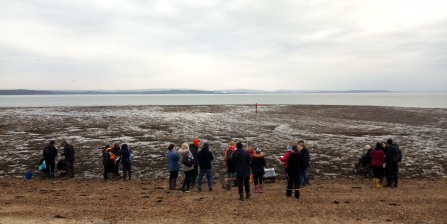We began this year’s intertidal surveys on the last spring tide weekend before the start of British Summer Time, which will give us more evening daylight to work with. This was also the lowest spring tide of the year – as such, more of the beach was exposed than we usually get to see, revealing a variety of crabs, starfish and sponges as well as the usual selection of molluscs and even the odd fish!
At Calshot, we had eight surveying stalwarts attending, and shared the beach with the Maritime Archaeology Trust, who were investigating Roman and Bronze Age wooden structures uncovered by the very low tide. The extent of this low tide also uncovered concrete and metal debris that we rarely get to see, and we found live native oysters (Ostrea edulis) there. This species is severely depleted and therefore no longer easy to find in the Solent, so we took GPS-tagged photos for submission to Natural England.
Inside an old drainage pipe we found an anemone, although the only way to see the detail needed to identify it was to stuff a camera in and hope for the best! From my photo you can just see the stripes on the column, making it Sagartiogeton undatus (no common name). If anyone from the survey has a better photo showing lines on the tentacles this will help to confirm the identification, so please let us know.


